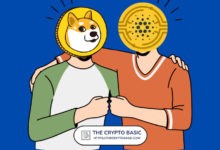What Are Flatcoins and Are They a Better Inflation Hedge?

As inflation rates go to the moon, so-called “flatcoins” are coming along for the ride.
Flatcoins are a new category of stablecoins that are pegged to the cost of living instead of real-world assets such as fiat currencies. Blockchain development house Laguna Labs is launching one of the first digital assets in this new category. If successful, their flatcoin could represent a legitimate inflation-hedging cryptocurrency as global inflation figures remain hot.
Their NUON flatcoin is pegged to the value of what $1 was on July 1, 2022. Once a day, the flatcoin’s value recalibrates to account for US dollar inflation. One NUON — worth $1 four months ago — was valued at $2.04 on Monday.
To produce its daily inflation adjustment, Laguna Labs developed the Truflation algorithm, which tracks price movement across ten million items and produces a daily inflation estimate that mostly tracks with Fed estimates.
With inflation at multiple-decade highs, dollar-pegged stablecoins such as Circle’s USDC and Tether’s USDT depreciate in value relative to the cost of goods over time. A flatcoin such as NUON holds its value through periods of inflation. Coinbase CEO Brian Armstrong and Ethereum co-founder Vitalik Buterin have both advocated for cryptos pegged to the cost of goods rather than fiat currencies.
A flatcoin, as mentioned by @VitalikButerin@brian_armstrong @balajis and many more recently, even tradfi people, a coin pegged to an independent inflation index, making it unaffectable by USD inflation or any centralized monetary policy. A cup of coffee costs 1 Nuon forever! pic.twitter.com/e5uRecBOSQ
— Nuon Finance (@NuonFinance) October 21, 2022
Like most major stablecoins, NUON is intentionally overcollateralized — and will automatically liquidate user loans if the value of their collateral falls below a given level. The hurdle Laguna Labs faces is maintaining an ever-increasing peg, as US inflation has occurred every year since 1954.
NUON’s algorithm tinkers with the coin’s collateralization ratio so traders will keep NUON at its peg. The collapsed Terra stablecoin used a similar system, though the coin was not fully collateralized. As long as investors are willing to mint and burn NUON, the flatcoin’s value ought to remain roughly flat — despite inflation.
Stefan Rust, CEO of NUON developer Laguna Labs, said he doesn’t see NUON competing with the likes of Circle or Tether but hopes the flatcoin can join bitcoin as investors’ go-to inflation hedge.
“Bitcoin is an amazing hedge against inflation, but it has got a level of volatility to it,” Rust said. “We’re trying to blend the best of both worlds where we take the user experience from the stablecoin market and the inflation hedge from bitcoin.”
A TradFi analogue for flatcoins is inflation-linked bonds, which adjust interest rates based on inflation and grew in popularity following the Great Recession. Like inflation-linked bonds, flatcoins become a less desirable asset when inflation cools down.
“If deflation happens, you are underwater, if you will, but your purchasing power always stays the same,” Rust said.
NUON is now running on a testnet with the intention of going live in the first quarter of 2023. The flatcoin will go live on decentralized crypto exchanges before seeking approval to be listed on centralized exchanges.







 Bitcoin
Bitcoin  Ethereum
Ethereum  Tether
Tether  USDC
USDC  Dogecoin
Dogecoin  Cardano
Cardano  TRON
TRON  Bitcoin Cash
Bitcoin Cash  Chainlink
Chainlink  Polygon
Polygon  Litecoin
Litecoin  Dai
Dai  LEO Token
LEO Token  Ethereum Classic
Ethereum Classic  Hedera
Hedera  Cronos
Cronos  Cosmos Hub
Cosmos Hub  Stellar
Stellar  OKB
OKB  Stacks
Stacks  Maker
Maker  Monero
Monero  Theta Network
Theta Network  Algorand
Algorand  NEO
NEO  Gate
Gate  KuCoin
KuCoin  EOS
EOS  Tezos
Tezos  Synthetix Network
Synthetix Network  IOTA
IOTA  Bitcoin Gold
Bitcoin Gold  Tether Gold
Tether Gold  TrueUSD
TrueUSD  Zilliqa
Zilliqa  Enjin Coin
Enjin Coin  Holo
Holo  Siacoin
Siacoin  Ravencoin
Ravencoin  0x Protocol
0x Protocol  Qtum
Qtum  Zcash
Zcash  Basic Attention
Basic Attention  Dash
Dash  NEM
NEM  Decred
Decred  Ontology
Ontology  Lisk
Lisk  Waves
Waves  DigiByte
DigiByte  Numeraire
Numeraire  Nano
Nano  Status
Status  Hive
Hive  Pax Dollar
Pax Dollar  Steem
Steem  Huobi
Huobi  OMG Network
OMG Network  BUSD
BUSD  Ren
Ren  Bytom
Bytom  Bitcoin Diamond
Bitcoin Diamond  Augur
Augur  Kyber Network Crystal Legacy
Kyber Network Crystal Legacy  Energi
Energi  HUSD
HUSD